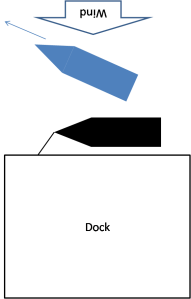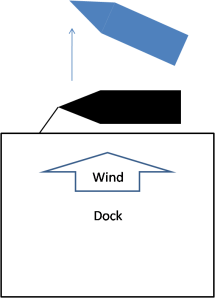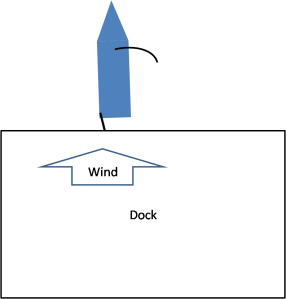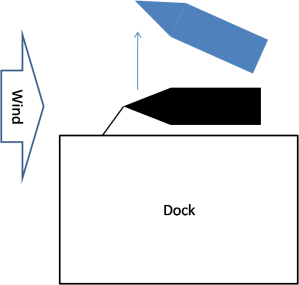Your boat is rigged, you’ve got a safety plan, and you’re finally ready to leave the dock. So, how do you steer your sailboat away from the safety of the dock without damaging other boats or ending up on the rocks? Regardless of the size of the vessel, and whether you are using an engine or sailing directly off the dock, it is important to note three factors:
- Wind direction and strength:The most important thing to notice is whether the wind is blowing on the dock, off the dock, or along the dock.
- Current direction and strength:It is important to notice whether the current and the wind are blowing in the same direction or opposing direction. Again, notice whether the current moving onto the dock, along the dock, or off the dock.
- Obstacles immediately off the dock (such as boats, rocks, etc).
Leaving the dock when the wind is blowing off dock
This is a relatively easy way to leave the dock. The goal is to allow your bow to leave the dock first, establish some speed, and gradually steer away from the dock. If you are in a small boat with the sails up, you can ease your sail and bring your boat alongside the dock, untie the bow line and either allow your bow to drift off the dock or gently pull on the dock at the stern forcing your bow off the dock. It is important to know that your sailboat will not steer unless it is moving through the water. As your bow moves away from the dock, keep your sail(s) eased to allow your boat to turn away from the wind.
If you are motoring off the dock, you should detach your lines so the bow leaves the dock first (for more on using your dock lines, check out this post). Once your bow is off the dock, simply take in your other lines and steer away from the dock.
Common Mistakes
Steering your bow off the dock with a stern line still attached – When your sail is full but you are still attached to the dock, it becomes difficult to release the stern line. On windy days your boat may leave the dock in an uncontrolled manner, making it difficult to steer. Make sure you release your stern line as soon as you leave the dock, or simply remove the stern line before you even begin to sail off the dock.
Jibing your boat as soon as you leave the dock – As you steer off the dock make sure you don’t turn too sharply. This will cause your boat to jibe and may temporarily cause a loss of control, and may even land you back on the dock. To avoid this, gently sail off the dock while slowly turning your boat keeping the wind coming over the side of your boat instead of over the stern.
When the current is moving very strongly onto the dock – If the current is much stronger than the wind you are going to have difficulty sailing off the dock. If you have to leave the dock in these conditions, you must very quickly establish speed. Either by using your lines, or a friend, force your bow off the dock, sheet in your sail(s) slightly and gain speed as quickly as you can. If possible, keep your boat on a broad reach (check out the post on the points of sail for more information) to help increase your speed.
Leaving the dock when the wind is blowing along the dock
Leaving the dock when the wind is blowing alongside the dock is very similar to when the wind is blowing off the dock as long as the bow is facing the direction of the wind. The key to leaving the dock when the wind is blowing alongside the dock is to ensure that the bow of the boat leaves the dock first allowing the wind to help push the boat off the dock as shown in the picture below.
When the wind is blowing along the dock and the stern is facing the direction of the wind, you have two options. First, you can release the stern line and swing the boat around so the bow is facing the wind, or you can sail or maneuver off directly. The challenge of attempting to steer off the dock with the wind on the stern is that the wind will push the bow back onto the dock. To do this, make sure your sail is on the same side of your boat as the dock. As soon as you start to sail off the dock, sheet in your sail and bring your boat to a beam reach.
Common Mistakes
Not removing your stern line – This will cause your boat to swing all the way around and jibe while still on the dock.
Drifting back into the dock or another boat that is downwind of your boat – when the stern is facing the wind, not gaining enough speed or trying to turn too quickly may result in your boat losing steerage and drifting downwind into whatever boat or obstacle is there. This may also occur if there is a strong current flowing onto the dock. To avoid this, turn your boat to face the wind before leaving the dock.
Leaving the dock when the wind is blowing on dock
This is by far the most difficult situation in which to leave the dock, since as soon as you steer your bow off the dock, the wind will blow it back on. The general rule is to force the bow off the dock, either by someone pushing, or by using your dock lines to force the bow off the dock. Once your bow is away from the dock, quickly sheet in your sails and attempt to gain as much speed as possible while steering a course that will just allow you to clear the dock. If you are using a motor, it is important to quickly increase your speed to gain steerage and steer directly away from the dock.
When the current is also moving onto the dock it is even more difficult to leave the dock. You may need a large push or even a tow to leave the dock under these conditions.
Common Mistakes
Turning into the wind – If you turn your boat into the wind too much, your sails will luff, you will lose momentum, and you will be blown back down onto the dock. To avoid this, steer your boat so you just clear the dock and then tack when you need to change directions.
Stay tuned for more information on leaving the dock under advanced conditions.
Filed under: Fundamentals | Tagged: docking, learn to sail, sailing | Leave a comment »









